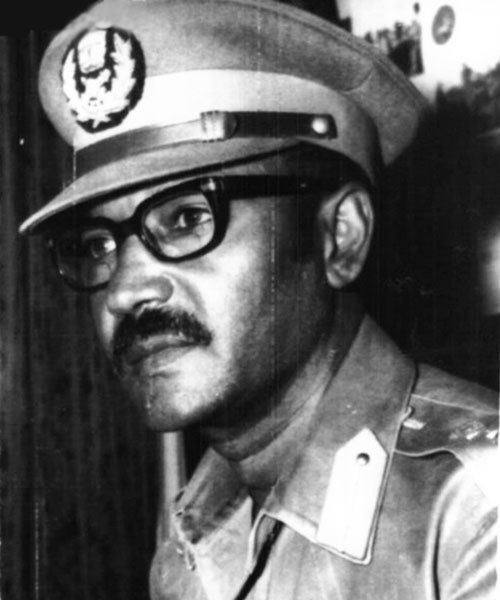Monarch Asfaw Wossen Name Tafari Benti Preceded by Aman Mikael Andom | Appointed by Haile Selassie I Rank Brigadier general Years of service 1941–1974 | |
 | ||
Unit Second DivisionThird DivisionFourth Divisions Service/branch Ethiopian National Defense Force Similar People Mengistu Haile Mariam, Aklilu Habte‑Wold, Haile Selassie, Isaias Afwerki, Hamid Idris Awate | ||
Tafari Benti
Brigadier General Tafari Benti (Amharic: ተፈሪ በንቲ?; October 1921 – 3 February 1977) was the Head of State of Ethiopia (28 November 1974 – 3 February 1977), and chairman of the Derg, the ruling junta. His official title was Chairman of the Provisional Military Administrative Council.
Contents

Early life and career

Tafari Benti was born near Addis Ababa. He joined the Ethiopian army at the age of 20, graduated from the Holetta Military Academy, and served in the Second, Third and Fourth Divisions. In 1967, he served as a military attaché in Washington, D. C., where he and several other Ethiopian colleagues suffered from racial discrimination.
On the evening of 23 November 1974, the charismatic Lt. General Aman Mikael Andom, the president of Ethiopia, and who had been in a struggle for power with the other members of the Derg, was killed in a shootout at his home. Mengistu Haile Mariam served as interim president until the Derg appointed Tafari Benti to the position. He had been serving as brigadier general in the Fourth Division, which was stationed in Asmara, at the time of this appointment.
Tenure
During his tenure Tafari presented himself as the public face of the ruling junta. According to the Ottaways, while at first he was "a neutral and powerless figure", in the end "he was too colorless, soft-spoken, and undemonstrative to be the figurehead of the revolution." However, according to Rene LaFort's account, Tafari offered some hints that he supported those opposed to Mengistu. One such hint was in July 1975, when in a public speech he made overtures to the civilian left—groups which included the Ethiopian People's Revolutionary Party (EPRP) and MEISON—proposing a united front "of all the forces that rejected the ancient regime, built from the base, that is from the mass organizations born of the great reforms"; LaFort points out that this was "a strategy which Mengistu Haile Mariam and his supporters opposed and would continue to oppose more and more resolutely." He repeated this message in a speech on the first anniversary of the deposition of Emperor Haile Selassie.
Over the following months, according to LaFort the Derg was split over irreconcilable objectives: "How could the authority of the Committee be strengthened while avoiding the dangers of authoritarianism, and how could the principles of collegiality be maintained while gaining maximum benefit from a concentration of power?" And behind this split was concern at Mengistu's growing power. To end this split, the Derg set up a committee chaired by Captain Mogus Wolde Mikael to reform the Derg's structure. After nine of weeks of what LaFort describes as "strenuous internal negotiations", on 29 December 1976 Tafari delivered a speech, announcing that the Derg had been restructured. The reorganization limited Mengistu's powers and sent his supporters out of the capital to positions in the countryside; on the other hand, two of the key architects of this reform, Captain Mogus and Captain Almayahu Haile, were appointed to powerful positions. His enemies had thought they had clipped Mengistu's wings and had removed him as a threat. Tafari Bente went even further and, flanked by Captains Mogus and Almayahu, criticized the lack of a vanguard party in words which LaFort interprets as declaring "the bloody war between MEISON and the EPRP to be politically unjustifiable, and that it should in any case remain limited to the civilian Left without the army intervening in any way."
Death
Despite this apparent setback, Mengistu proved to be far more resourceful than his opponents believed. He conspired with his longtime friend and ally Lieutenant Colonel Daniel Asfaw to round up Tafari Benti and other Derg members suspected of conspiring with the Ethiopian People's Revolutionary Party (EPRP). During a routine meeting on 3 February 1977, Tafari Benti and the other Derg members suspected of conspiring with the EPRP were arrested by soldiers under the command of Lieutenant Colonel Daniel. According to the memoirs of Fikre Selassie Wogderess, they were then led into a dark garage located in the compound and locked up. Fikre Selassie was also present at the meeting and was mistakenly arrested along with Tafari and the other suspect Derg members. However, Lieutenant Colonel Daniel Asfaw arrived at the garage in time and released Fikre Selassie before the summary execution of the others. Shortly thereafter soldiers armed with automatic weapons and silencers arrived and assassinated Tafari Benti and the suspect Derg members: Lieutenant Alemayehu Haile, Captain Mogus Wolde Michael, Corporal Hailu Belay, Lieutenant Colonel Asrat Desta, Lieutenant Colonel Hiruy Haile Selassie and Captain Tefera Deneke. Later, in the evening, a shootout opened in the same compound by another suspected EPRP conspirator Major Yohannes Tiku, where he killed Lieutenant Colonel Daniel and Senay Likke. Major Yohannes Tiku was also killed in the shootout.
Shortly afterwards, Radio Ethiopia broadcast a charge by Mengistu that Tafari and his associates had been killed because they were secret supporters of the EPRP. Mengistu claimed he had discovered a 47-page master plan in Tafari's possession, which detailed how the EPRP would replace the "scientific socialism" of the Derg.
